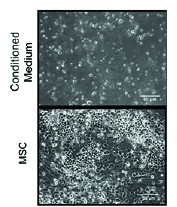What could an NC3Rs Training Fellowship do for you?

Our Training Fellowship scheme supports the development of promising early career researchers with less than three years’ postdoctoral experience.
The scheme focuses on helping Fellows to develop new skills and gain a breadth of research experience to prepare them for an independent career in academia.
In 2017, we spoke to Dr Deepali Pal about her experience of applying for early career stage awards after she was awarded her Training Fellowship in 2016. Now Deepali has finished her Fellowship, we caught up with her again to find out how being an NC3Rs Training Fellow has helped advance her career.
Why did you apply to be an NC3Rs Training Fellow?
Following medical training and an MSc in medical genetics I was awarded a Marie Curie Fellowship to do my PhD in stem cells and prostate cancer. During my early research days, I began to realise the role played by animal models in cancer research, which were regarded as the gold-standard preclinical models. This inspired me to think about human cell-based models that could be used to look at clinical cancer samples within the context of the surrounding microenvironment, while replacing the use of animals.
I decided to apply for an NC3Rs Fellowship to help me pursue my ambitions of establishing my own research group in academia and developing clinically meaningful human cell-based animal replacement models. I was very grateful to receive the award and feel privileged to champion animal replacement models as a life-long 3Rs ambassador.

My Fellowship project aimed to replace animals in preclinical testing of children’s blood cancer by reprogramming human bone marrow stroma to generate induced pluripotent stem cells, or iPSCs. This meant we could differentiate into cell types such as mesenchymal stem cells, and their bone, fat and cartilage derivatives, as well as endothelial and perivascular cells. Using all these cell types, I was able to represent the microenvironment that clinical samples need to retain function and therefore study tumours in a realistic context – a unique feature of my approach.
Using this model, I have been able to reveal new mechanisms underlying interactions between tumours and the bone marrow environment and thus identify new and safer treatment strategies to target these interactions. There has previously been a heavy dependence on mouse models in cancer research and my aim is to reduce dependence on these animal models using my synthetic human cell-based platform.
What do you consider to be your main achievements as an NC3Rs Training Fellow?
My Fellowship gave me the opportunity to establish collaborations, which helped me develop new multidisciplinary research projects and improve my publication profile. As my research uses clinical samples, I particularly wanted to develop and maintain links with hospitals.
I also formed new collaborations with Animal Welfare Ethical Review Body (AWERB) scientists so I could impact animal replacement locally. Following endorsement of my platform through these networks, I have been able to replace the use of 73% of mice in leukaemia research used in Newcastle University in the last year, a total of over 2,500 animal experiments impacted. My aim now is to ensure this replacement is reproduced at a larger scale, so I have started forming links with academic groups and commercial companies across the UK and globally. Although my platform has been used to replace animal experiments in leukaemia research in the first instance, the foundation of this platform is formed by connective tissue and vascular cell types. Hence this platform can be applied to bring about animal replacement in other diseases of the bone marrow as well as solid tumours of bone and soft tissues.
During my Training Fellowship, I published five original research papers with a further three in submission. I was awarded three grants – as principal investigator, co-investigator and named collaborator on a comprehensive research programme – and received invitations to give talks and chair sessions at national and international conferences. I was also very fortunate to be listed by the NC3Rs as a celebrated female researcher on International Women’s Day 2018. These achievements helped me secure my first independent position as a tenured research academic.
What are you up to now after your Fellowship?
I am now a Senior Lecturer based in the Department of Applied Sciences at Northumbria University where I am beginning to establish my research group. My research strategy has two core aims: to replace animal experiments in cancer research with human cell-based models, and to develop new biology-driven cancer treatments.
My research group are using both organoids and 3D bioprinting to develop pluripotent stem-cell derived microtissue models. With complex 3D models such as these, there is a need for improved analytical techniques that can extract meaningful data. I have therefore initiated collaborative links with the Wyss Institute at Harvard University to optimise and apply a novel “on-site” RNA sequencing technology to obtain gene expression data in intact patient-derived organoids.
How has being an NC3Rs Training Fellow helped your career progression?
The Training Fellowship gave me the guidance and support I needed to progress to an independent academic position. It provided me time to concentrate on developing my own research strategy, which I think was critical for establishing my career in academia.
During my Fellowship, I attended several courses and meetings hosted by the NC3Rs, which were pivotal in preparing me for the transition into academic independence. I feel that junior scientists can sometimes place too much importance on completing technical tasks or learning protocols laid out by a supervisor or senior post-doc. Although laboratory skills are needed, especially at the beginning of a research career, I feel the skill that really develops a good scientist is the ability to see the bigger picture and design your own research projects. This enables you to apply for your own research income and organise infrastructure for successfully executing these projects to completion.
Most importantly, I felt the NC3Rs team were always there to support me during any challenges that I faced.
What skills did you learn as a Fellow and how are you using these now in your career?
Through my Fellowship, I began to really appreciate the value of interdependence: working with others to build mutually supportive relationships. This helped me develop new collaborations and progress those I already had in a meaningful way.
I also gained skills that helped me develop my independent research strategy and design research projects, enabling me to write better grant proposals. Establishing links with industry was another instrumental skill I developed during my Fellowship – I learnt about intellectual property and improved my understanding of research commercialisation through an NC3Rs course given by Stevenage Biosciences Catalyst.
Taken altogether, these skills have helped me to think about the bigger picture of where I want my research to go, while paying attention to relevant details and planning any necessary infrastructures to successfully execute my research projects. These skills have also been important in raising my research profile to ensure my 3Rs methods are endorsed by other groups, both in academia and industry, so I can maximise the 3Rs impact of my research.
Looking back, do you have any advice for anyone who might be thinking of applying to the scheme?
I do! I’ve put together my top tips for anyone thinking of becoming an NC3Rs Training Fellow:

Deepali put together her top tips for anyone applying to the Training Fellowship scheme.
- Think about the bigger picture of your research, but make sure to focus on the details relevant to you.
- Don’t forget that designing a project and executing it are quite different. Think about what infrastructure you would need and how you would secure it.
- Accept the journey ahead will be difficult at times and embrace the challenge.
- Always seek guidance and advice on grant proposals and publication drafts from your mentors and senior scientists. Reflect on these and make your own decisions.
- Perseverance and positive thinking are key.
- Don’t fear failure, as you can always learn something from the experience. Forgive yourself and move on to the next step – night always brings another day.
You can read more about Deepali’s Training Fellowship here, and also about her experience applying for early career awards in our previous blog post.
Our 2021 Training Fellowship scheme is currently accepting applications. The deadline to apply is 4pm (BST) on Thursday 9 September.
